We’ve gone over it a million times, both the jubilation of Independence and the terror of Partition. Trysts with destinies, one-man boundary commissions and the nighttime trains of death. Reading of a mad man spreadeagled on the boundary of two warring infant nations in which everyone has gone crazy.
So many times, that it’s all a bit of a blur now; jaded even. So let’s reset – and take a look at it through the eyes of the people who lived through it the first time. Here are some newspaper accounts of the final months leading up the August 15, 1947.
Mountbatten Plan for Partition
The final plan for a united India was the Cabinet Mission, announced in the fiery summer of 1946. For six months, the British, the Congress and the Muslim League fought over the plan, sparring over its legal minutiae. By the end, it fell through: the Congress rejected it, unhappy with how little power the Centre had. Famously, Nehru announced that the Congress would enter the Constituent Assembly “completely unfettered by agreements”.
With India hurtling into anarchy, the British Viceroy, Lord Mountbatten resurrected a plan drawn up by Indian civil servant, VP Menon, which proposed a complete partition into two dominions under the British crown. He ran it by Nehru on May 10, who preferred it greatly to the alternative: a transfer of power to the provinces.
It was announced on June 3 and served as the final blueprint for transfer of power.
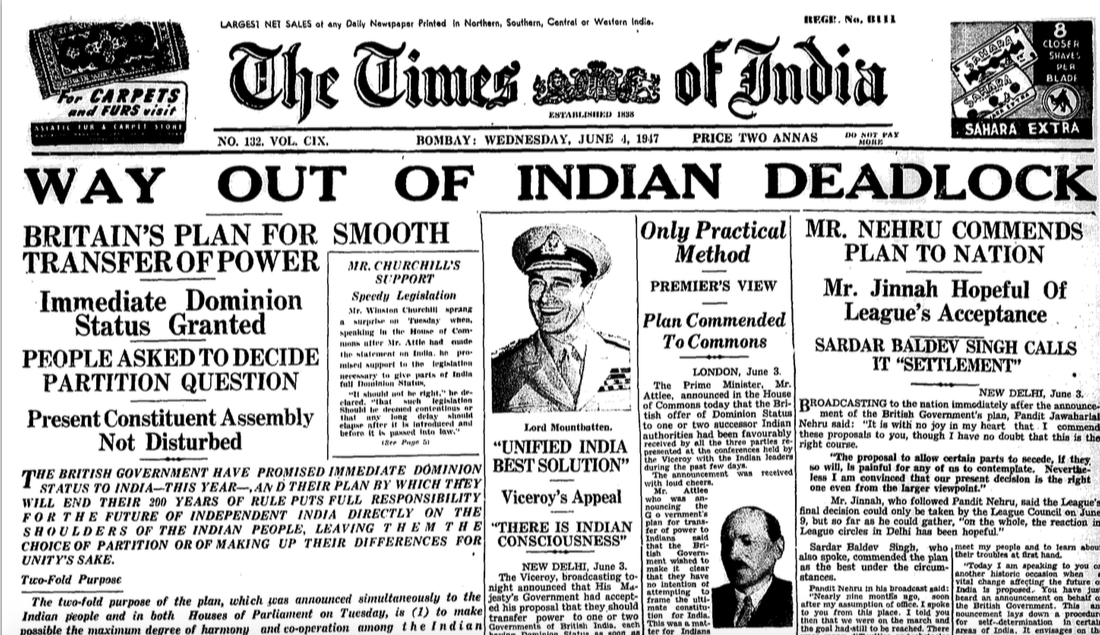


While people had mixed feelings about the Mountbatten Plan – there was happiness at Independence but there was also Partition – one enterprising business decided to junk any hand wringing and utilise this for some profit. B Lilaram and Sons, silk merchants, taliors and outfitters of Lahore, therefore, proudly put out an advertisement on the outline of united India, on the very same day that Partition had been announced, congratulating everyone on this "auspicious occasion".

This might seem funny to us now, but it shows that barely three months to Partition, no one even knew what it meant. Of course, Lilaram was also a pioneer of sorts: today millions of businesses in India follow in his footsteps and use Independence Day as a marketing opportunity.
Bengal and Punjab Partitioned
What the partition of India actually entailed was the partition of the great provinces of Bengal and Punjab, the lifeblood of British India. The Mountbatten plan had a procedure where the east and west halves of each provincial legislature would vote separately and if either voted to partition their provinces, the decision would be carried.
While this was technically a free vote, given the bitter communalisation at the time, legislators simply voted as per their religion. In Bengal, the vote was held on June 20, 1947. Western Bengal decided for partition and to join up with India. Eastern Bengal decided to keep the province united but part of Pakistan. The final result was, of course, the map that you see now, with West Bengal in India and East Bengal, first part of Pakistan and then, emerging as a free country, Bangladesh.



It is interesting to see the tone of headlines differ between the Statesman (a British newspaper), the Amrita Bazar Patrika (a pro-Congress newspaper) and the Star of India (a pro-Muslim League newspaper). The Patrika reports the joining of "Non-Muslim majority areas" with the Indian Union as a "fateful decision". The Star of India highlights that West Bengal had voted for Partition and The Statesman – with no dog in this fight – runs a headline which doesn't make a value judgment.
The same process was followed for the Punjab.

On the inside pages of the Statesman, though, an ominous portent on the same date the Punjab partition was voted on: a Hindu Mahasabha rejection of the Mountbatten Plan and calls to militarise.
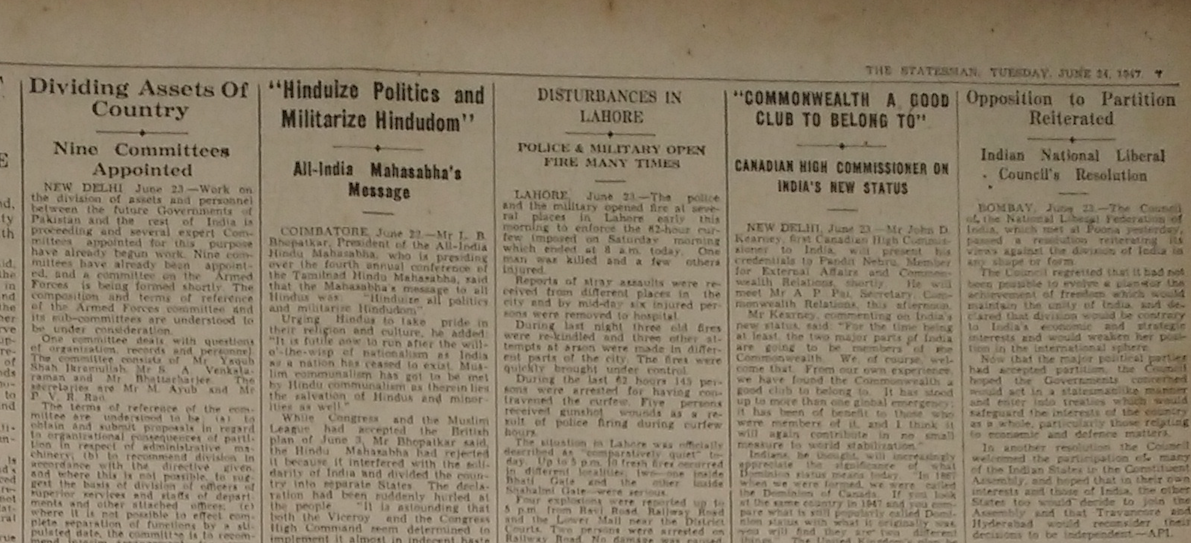
When the partition of Punjab went through, all law and order broke down in the province with lakhs killed and millions displaced. Each half of the province would empty itself of its minorities – Muslim heading west, Hindus and Sikhs, east – the largest instance of ethnic cleansing the world has ever seen.
Independence
The Mountbatten plan was operationalised on August 15, with India and Pakistan becoming self-governing dominions under the British Crown (the Congress dream of purna swaraj, or complete freedom would only come in 1950 for India).
Newspapers across India greeted the moment with joy.
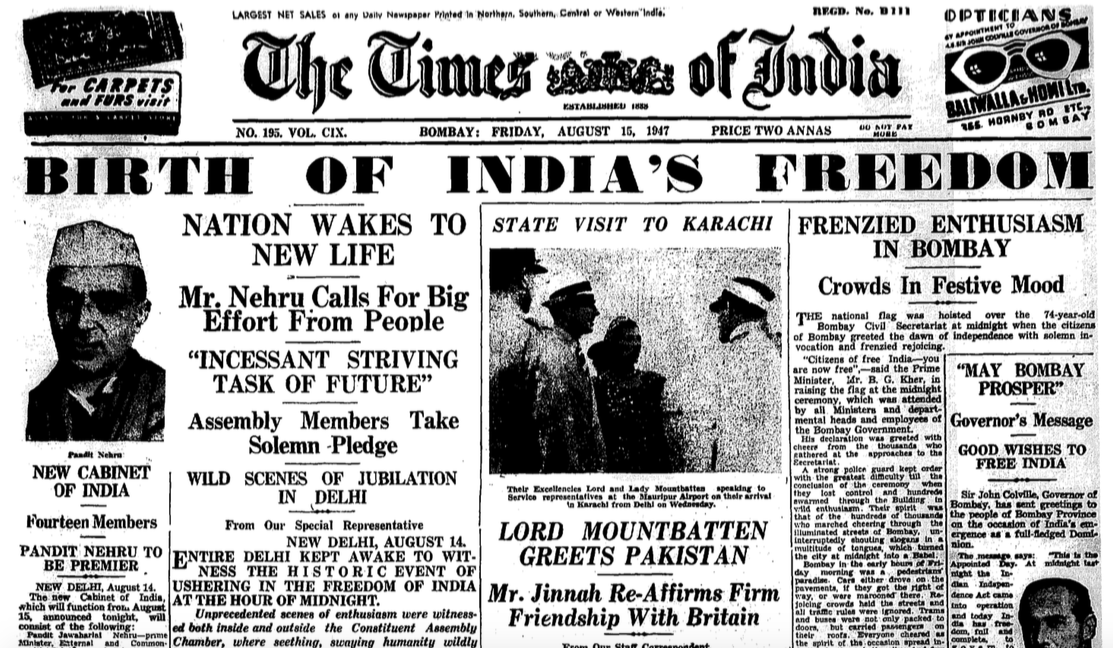

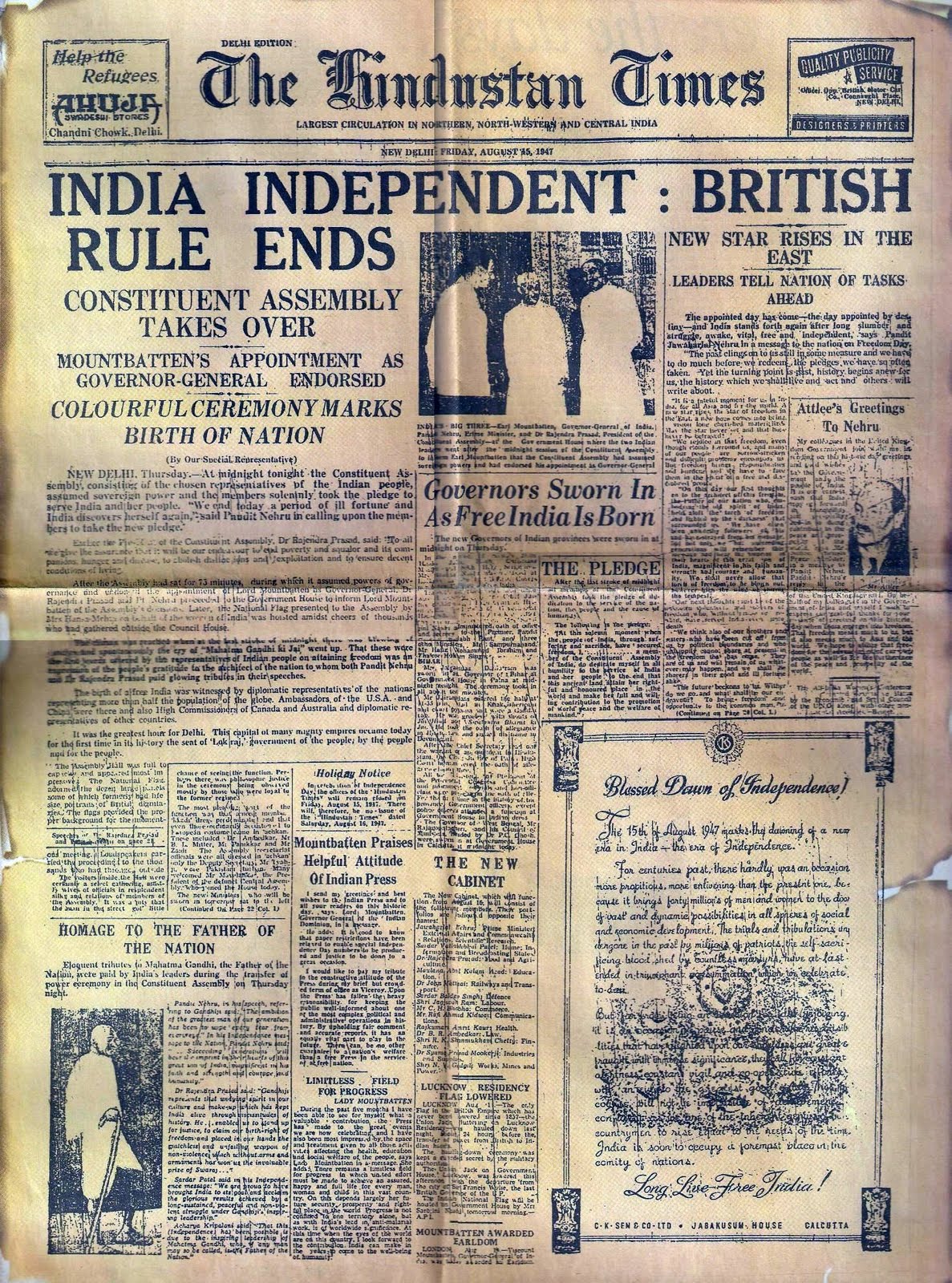
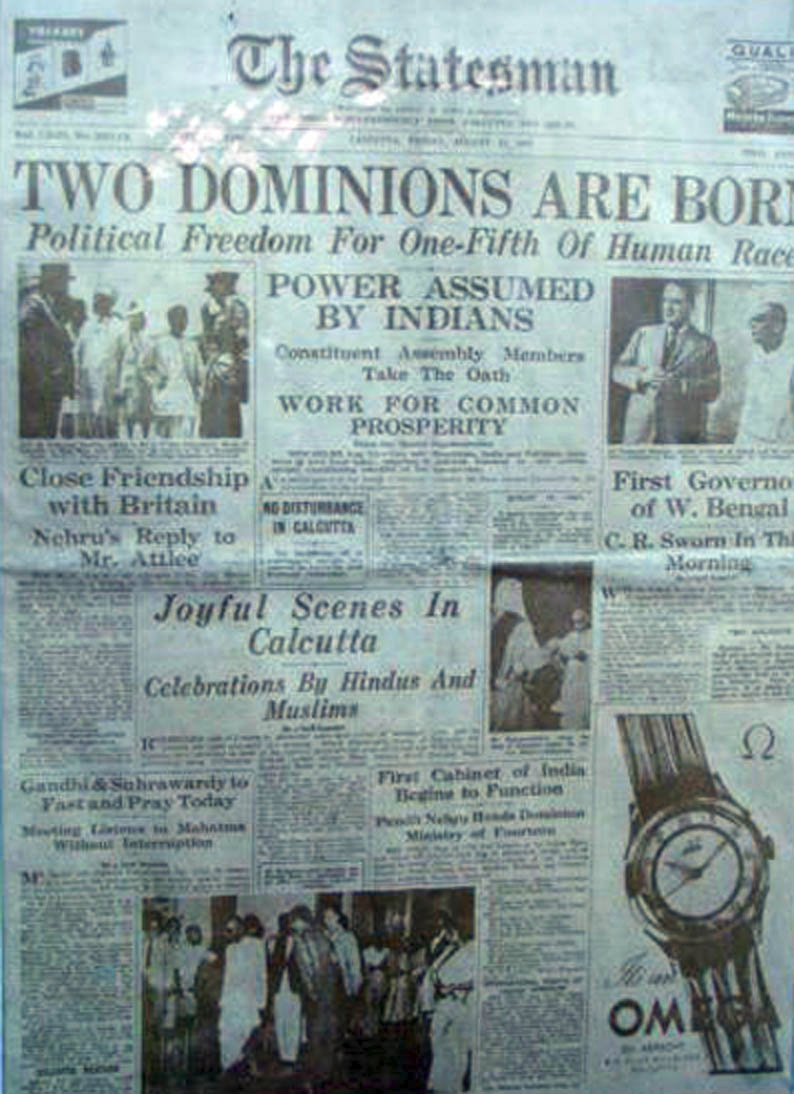
Over in Pakistan, though, the mood was more sombre. Partition, while it had affected India significantly, had almost crippled Pakistan. Moreover, the rushed nature of the process meant that Pakistan had to set up a whole new state from scratch in a little over two months. Mountbatten had described the difference between India and Pakistan in August 1947, thus: “Administratively it was the difference between putting up a permanent building, a nissen hut or a tent. As far as Pakistan is concerned we are putting up a tent. We can do no more." In fact, Pakistan was only able to remain solvent in its first budget because of an emergency loan from the princely state of Hyderabad, an act that angered India greatly.
The Civil and Military Gazette, published from Lahore, the epicentre of the Partition holocaust, did not even bother with reporting any news of independence or freedom on its front pages on August 15, although the previous day, Lord Mountbatten had formally transferred power to the Constituent Assembly of Pakistan.
A news item, carried on August 14, announced that the Muslim League would not carry out any celebrations in West Punjab in view of the disturbances.
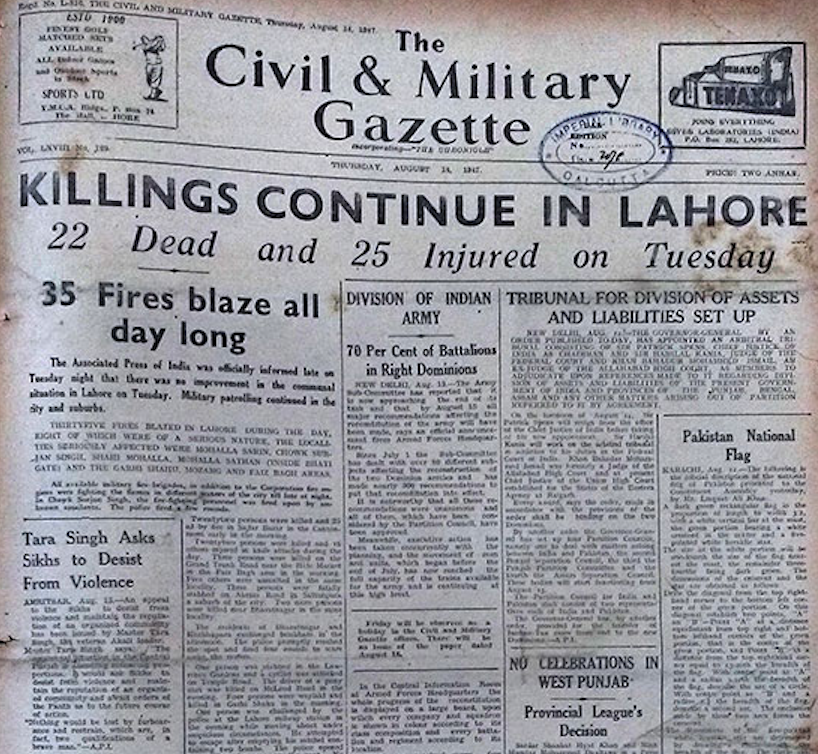

In the midst of this gloom, Stanley Wolpert mentions that Mountbatten, however, found a moment of levity when Jinnah scheduled a lunch programme for the Viceroy. Unfortunately, the irreligious founder of the soon-to-be Islamic state of Pakistan had clean forgotten that this was the Islamic month of dawn-to-dusk fasting, Ramzan, so the programme had to be changed to dinner.
Partition
A little-known fact : August 15 was Independence Day but Partition actually took place two days later. Mountbatten kept the Partition of the Punjab and Bengal till after August 15 since, as he laid out himself in his report to London, “it had been obvious all along that the later we postponed publication [of the new border], the less would be the inevitable odium react upon the British”.
Which in plain English means that India and Pakistan would bear the responsibilities for the Partition massacres not, the ex-rulers (by two days), the British. This was done even as any delay meant even more panic and, consequently, even more death.


So many times, that it’s all a bit of a blur now; jaded even. So let’s reset – and take a look at it through the eyes of the people who lived through it the first time. Here are some newspaper accounts of the final months leading up the August 15, 1947.
Mountbatten Plan for Partition
The final plan for a united India was the Cabinet Mission, announced in the fiery summer of 1946. For six months, the British, the Congress and the Muslim League fought over the plan, sparring over its legal minutiae. By the end, it fell through: the Congress rejected it, unhappy with how little power the Centre had. Famously, Nehru announced that the Congress would enter the Constituent Assembly “completely unfettered by agreements”.
With India hurtling into anarchy, the British Viceroy, Lord Mountbatten resurrected a plan drawn up by Indian civil servant, VP Menon, which proposed a complete partition into two dominions under the British crown. He ran it by Nehru on May 10, who preferred it greatly to the alternative: a transfer of power to the provinces.
It was announced on June 3 and served as the final blueprint for transfer of power.



While people had mixed feelings about the Mountbatten Plan – there was happiness at Independence but there was also Partition – one enterprising business decided to junk any hand wringing and utilise this for some profit. B Lilaram and Sons, silk merchants, taliors and outfitters of Lahore, therefore, proudly put out an advertisement on the outline of united India, on the very same day that Partition had been announced, congratulating everyone on this "auspicious occasion".

Ad in the Civil and Military Gazette
This might seem funny to us now, but it shows that barely three months to Partition, no one even knew what it meant. Of course, Lilaram was also a pioneer of sorts: today millions of businesses in India follow in his footsteps and use Independence Day as a marketing opportunity.
Bengal and Punjab Partitioned
What the partition of India actually entailed was the partition of the great provinces of Bengal and Punjab, the lifeblood of British India. The Mountbatten plan had a procedure where the east and west halves of each provincial legislature would vote separately and if either voted to partition their provinces, the decision would be carried.
While this was technically a free vote, given the bitter communalisation at the time, legislators simply voted as per their religion. In Bengal, the vote was held on June 20, 1947. Western Bengal decided for partition and to join up with India. Eastern Bengal decided to keep the province united but part of Pakistan. The final result was, of course, the map that you see now, with West Bengal in India and East Bengal, first part of Pakistan and then, emerging as a free country, Bangladesh.



It is interesting to see the tone of headlines differ between the Statesman (a British newspaper), the Amrita Bazar Patrika (a pro-Congress newspaper) and the Star of India (a pro-Muslim League newspaper). The Patrika reports the joining of "Non-Muslim majority areas" with the Indian Union as a "fateful decision". The Star of India highlights that West Bengal had voted for Partition and The Statesman – with no dog in this fight – runs a headline which doesn't make a value judgment.
The same process was followed for the Punjab.

On the inside pages of the Statesman, though, an ominous portent on the same date the Punjab partition was voted on: a Hindu Mahasabha rejection of the Mountbatten Plan and calls to militarise.

When the partition of Punjab went through, all law and order broke down in the province with lakhs killed and millions displaced. Each half of the province would empty itself of its minorities – Muslim heading west, Hindus and Sikhs, east – the largest instance of ethnic cleansing the world has ever seen.
Independence
The Mountbatten plan was operationalised on August 15, with India and Pakistan becoming self-governing dominions under the British Crown (the Congress dream of purna swaraj, or complete freedom would only come in 1950 for India).
Newspapers across India greeted the moment with joy.




Over in Pakistan, though, the mood was more sombre. Partition, while it had affected India significantly, had almost crippled Pakistan. Moreover, the rushed nature of the process meant that Pakistan had to set up a whole new state from scratch in a little over two months. Mountbatten had described the difference between India and Pakistan in August 1947, thus: “Administratively it was the difference between putting up a permanent building, a nissen hut or a tent. As far as Pakistan is concerned we are putting up a tent. We can do no more." In fact, Pakistan was only able to remain solvent in its first budget because of an emergency loan from the princely state of Hyderabad, an act that angered India greatly.
The Civil and Military Gazette, published from Lahore, the epicentre of the Partition holocaust, did not even bother with reporting any news of independence or freedom on its front pages on August 15, although the previous day, Lord Mountbatten had formally transferred power to the Constituent Assembly of Pakistan.
A news item, carried on August 14, announced that the Muslim League would not carry out any celebrations in West Punjab in view of the disturbances.


In the midst of this gloom, Stanley Wolpert mentions that Mountbatten, however, found a moment of levity when Jinnah scheduled a lunch programme for the Viceroy. Unfortunately, the irreligious founder of the soon-to-be Islamic state of Pakistan had clean forgotten that this was the Islamic month of dawn-to-dusk fasting, Ramzan, so the programme had to be changed to dinner.
Partition
A little-known fact : August 15 was Independence Day but Partition actually took place two days later. Mountbatten kept the Partition of the Punjab and Bengal till after August 15 since, as he laid out himself in his report to London, “it had been obvious all along that the later we postponed publication [of the new border], the less would be the inevitable odium react upon the British”.
Which in plain English means that India and Pakistan would bear the responsibilities for the Partition massacres not, the ex-rulers (by two days), the British. This was done even as any delay meant even more panic and, consequently, even more death.


Scroll has produced award-winning journalism despite violent threats, falling ad revenues and rising costs. Support our work. Become a member today.

In these volatile times, Scroll remains steadfastly courageous, nuanced and comprehensive. Become a Scroll Member and support our award-winning reportage, commentary and culture writing.
